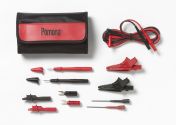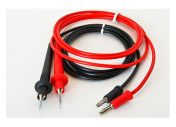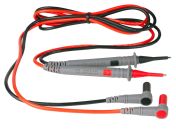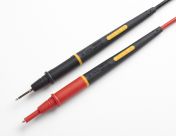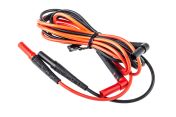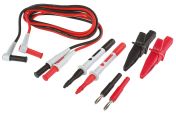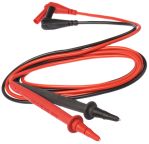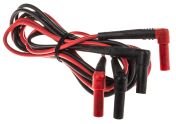Multimeter Leads with Banana Plugs
Multimeter leads with banana plugs are test leads equipped with banana plug connectors at one end, which are designed to connect to the input jacks of a digital multimeter. These leads offer a secure, standardised, and interchangeable connection, making them suitable for a wide range of users and applications in the field of electrical and electronic testing.
Multimeter leads with banana plugs consist of the following components:
- Banana Plugs - these are cylindrical connectors with a spring-loaded, banana-shaped pin at one end and a plug at the other. Banana plugs are available in sizes 2 mm and 4 mm (standard) and can fit into the corresponding banana jacks on multimeters.
- Insulated Wires - these test leads are typically constructed with insulated, flexible wires that can carry electrical signals from the banana plug end to probe tips or connectors at the other end.
- Probe Tips or Clips - the opposite ends of the leads often have probe tips or clips for making contact with the component or circuit being tested.
Why would you use multimeter leads with banana plugs?
- Ease of Connection - banana plugs provide a convenient and secure way to connect the test leads to the multimeter making them quick and reliable for testing.
- Interchangeability & Versatility - banana plugs are standardised connectors, so you can use the same set of leads with various types of test equipment that have banana jacks. Depending on the accessories (e.g., probe tips, clips) attached to the leads, they can be used for a wide range of measurements, including voltage, current, resistance, and more.
- Accuracy – help to minimise the risk of loose or unstable connections, which can lead to measurement errors.
- Safety - the insulated design of the leads enhances safety by preventing accidental contact with live electrical components.
Who would use multimeter leads with banana plugs?
- Electricians - for measuring voltage, current, and resistance in electrical circuits.
- Electronics Technicians - for diagnosing and troubleshooting electronic components and circuits.
- Engineers - for design verification and testing of electronic prototypes.
- Hobbyists - DIY electronics projects and repairs.
12 Products showing for Multimeter Leads with Banana Plugs
Results per page

